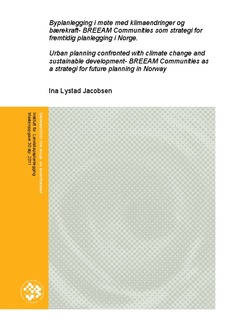| dc.description.abstract | Et historisk tilbakeblikk viser at planleggingsrollen har utviklet seg parallelt med de endringer og utfordringer som samfunnet til en hver tid har stått ovenfor. Sett i forhold til dagens situasjon innebærer dette at klimaendringer og målsetting om en bærekraftig utvikling er en stor del av planleggingens ansvarsområde. Ettersom samfunnsutviklingen er en dynamisk prosess kreves det samtidig kompetanse og evne fra planleggeres side når det gjelder å omstille seg etter nye endringer og tenke i et fremtidsrettet perspektiv. Samtidig ligger det store utfordringer i oppgaven med å utvikle samfunnet slik at både sosial, økonomisk og økologisk bærekraft ivaretas og fremmes i tilstrekkelig grad. Dette krever helhetstenking og et bredt fokus på hvordan arealdisponering, bygninger og rom fungerer i den helheten som samfunnet utgjør.
Til grunn for denne studien ligger en antagelse om at klimaendringer og målsettinger om bærekraftig utvikling vil legge føringer for hvordan byer og tettsteder utvikles i tiden fremover, samtidig ligger en antagelse om at dagens planleggingspraksis og samfunnsstyring ikke er tilstrekkelig i møte med de fremtidige utfordringene dette innebærer. På bakgrunn av dette tar utredningen utgangspunkt i spesielt tre endringsbehov ved den norske samfunnsutviklingen, de tre behovene er som følger:
Behov for konkrete prinsipper for en bærekraftig gjennomføring
Behov for samlede grep og helhetlig fokus
Behov for et bredere samarbeid mellom offentlig og privat virksomhet
Som en strategi for fremtidig planlegging i Norge tas det utgangspunkt i å belyse sertifiseringssystemet BREEAM Communities. Dette verktøyet har til hensikt å utføre en helhetlig vurdering av alle samfunnsmessige aspekter ved et planlagt utviklingsprosjekt, opp mot konkrete prinsipper for bærekraftig gjennomføring. Slik skal verktøyet sikre at sosial, økonomisk og økologisk bærekraft blir ivaretatt i fremtidige lokalsamfunn.
Ved å gjøre en vurdering av muligheter og begrensinger ved å implementere BREEAM Communities til Norge kommer det fram at sertifiseringssystemet kan bidra til å imøtekomme ovennevnte behov. Det er hovedsakelig BREEAMs konkrete prinsipper for hvordan bærekraft kan oppnås på et lokalt nivå som anses å være den største fordelen med verktøyet. Samtidig
- 3 -
kommer det frem at sertifiseringssystemets mulighet til å utvikle et bærekraftig lokalsamfunn reduseres betraktelig dersom beboere og brukere velger ikke å benytte seg av de bærekraftige mulighetene som BREEAM Communities legger opp til. Looking back in history the planning role has developed in a parallel manner to the changes and challenges that time has created. Seen in relations to today’s situation this means that climate changes and goals about a sustainable development is a big part of the planning roles responsibility. Due to the fact that social development is a dynamic process it requires a simultaneous knowledge and capability from the planner when it comes to restructuring new changes and to think in an innovative perspective. At the same time there will be challenges in the task of developing a society in a way that both the societal, economic and ecological sustainability is safeguarded and prompted adequately. This requires a holistic perspective and a wide focus of how land use, buildings and space operate in the totality that the society poses.
The basis of this study is the assumption that climate changes and objectives of sustainable development will add routing for how cities and towns will develop in the future, at the same time there is an assumption that current planning practices and governance are not sufficient enough to meet the future challenges this entails. Because of this, this report is based on three particular changing needs within the Norwegian social development, these three requirements are as follows:
- The need for concrete principles for a sustainable implementation
- The need for a gathered grip and an overall focus
- The need for a better cooperation between the public and private sectors
As a strategy for future planning in Norway a good starting point is highlighting of the certification system BREEAM Communities. This tool is intended to perform a comprehensive assessment of all aspects of a planned development project, against specific principles for sustainable implementation. This way this tool will ensure that social, economic and ecological sustainability are safe guarded in the future communities.
By making an assessment of the possibilities and limitations of implementing BREEAM Communities in Norway we see that the certification system can help to meet the above requirements. It is mainly BREEAMs specific principles for how sustainability can be achieved at a local level that is considered to be the biggest advantage of this tool. At the
- 5 -
same time it emerges that the certification system’s ability to develop a sustainable community is reduced considerably if the residents and users of this system chooses not to take advantage of the opportunities that the sustainable BREEAM Communities proposes. | en_US |
